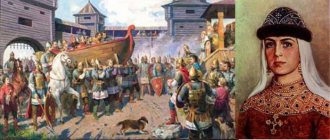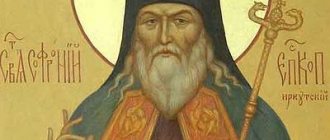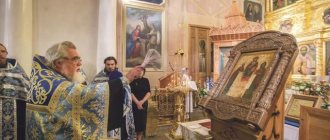Juliania, Princess of Vyazemskaya and Novotorzhskaya is a martyr, revered by Orthodox Christians, who lived a short earthly life. The saint was born at the end of the 14th century into a family of eminent boyars and died at a young age. The day of remembrance of the blessed princess Juliana is December 21 (January 3). The date of discovery of her relics is June 2 (15).
Biography of Saint Juliana
Juliania's parents were rich believers - Maxim Danilovich and Marya Nikitishna Gostomyslov. The girl became the first child in the family. She grew up without any siblings.
Juliania's early childhood was happy and took place in the city of Torzhok, located on the banks of the Tvertsa River. Here her father served as governor. At the age of 4, the girl lost her breadwinner, who was killed by local residents during a riot, and was left with her sick mother. Marya Nikitishna was very sad after the death of her husband, she cried incessantly and prayed to God. Her little daughter also read prayers with her. Even then she developed a deep love for the Holy Scriptures and church services.
Soon the woman’s health deteriorated even more. When her mother faded away and left this world, Juliania began to live in the house of her uncle Fyodor Danilovich, who was the brother of her late father. Here the orphan grew up among God-fearing people, surrounded by sincere love and care.
At the end of the day, Fyodor Danilovich often gathered his family and servants around him and read them the lives of saints and other sacred texts. Juliana always looked forward to these evenings and listened to every word of her uncle. Over the years, she turned into a prominent girl, whose beauty was enhanced hundreds of times by kindness, chastity, mercy and other numerous Christian virtues.
Notes
- About Pushkin’s relationship with Princess Vera, see V.V. Nabokov’s commentary on the famous stanza “I remember the sea before the storm...”
- Vigel F. F. Notes: In 2 books. - M.: Zakharov, 2003.
- [pushkin.niv.ru/pushkin/pisma/314.htm Letters from Pushkin.]
- Abramovich S.
[feb-web.ru/feb/pushkin/serial/isd/isd-169-.htm Letters from P. A. Vyazemsky about the death of Pushkin // Website “FEB. Russian literature and folklore".]. Retrieved May 14, 2012. [www.webcitation.org/6AqJIjopL Archived from the original on September 21, 2012]. - Obodovskaya I., Dementyev M.
After the death of Pushkin: Unknown letters / Ed. and ed. will enter. articles by D. D. Blagoy. - M.: Soviet Russia, 1980. - P. 188, 193, 195. - 384 p. - Memoirs of Count S. D. Sheremetev, 3 vols. - M, 2005.
- Memoirs of Prince A.V. Meshchersky.-M., 1901.
- Smirnova A. O. Notes, diary, memories, 2003.
- A.S. Pushkin. Collected works of A.S. Pushkin in ten volumes. T.10. Letters 1831-1837 - L.: Nauka, 1978.
Happy marriage and martyrdom
When Juliana reached the age suitable for marriage, she was given in marriage of her own free will. The girl’s husband was Simeon Mstislavovich, Prince of Vyazemsky. Like his chosen one, he had a meek disposition, was God-fearing, and always faithfully fulfilled God's commandments. The couple's life together was short-lived, but filled with love, happiness and harmony.
Juliania and her husband lived in an era when internecine wars, cruelty and violence flourished in Rus'. Soon, the native lands of Simeon Mstislavovich were captured by the Lithuanian ruler Vitovt, and the young family had to flee to Torzhok. Together with his spouses, Prince Yuri Svyatoslavovich of Smolensk also moved to this city. He was vicious and voluptuous, but hid his true essence from those around him. Subsequently, this man completely destroyed the happy life of the God-fearing couple.
Upon the arrival of the princes, Torzhok was divided into two equal parts. One of them began to belong to Simeon Mstislavovich, the second went to Yuri Svyatoslavovich. The men continued to be friends and often visited each other. Yuri was not only friends with Simeon, he secretly had sympathy for the blessed princess Juliana Vyazemskaya. Soon the voluptuous man stopped hiding his carnal desires and began to pursue a young beautiful woman and persuade her to commit adultery.
Having learned about Yuri’s dishonest intentions, Juliana began to fervently pray to the Lord, asking Him to bring him to his senses and stop him. However, the wicked man still demanded reciprocity from the princess and tried to achieve what he wanted with threats and entreaties. Despite all the tricks, the woman remained adamant and shamed her pursuer for his thoughts that were contrary to God.
One winter, the faithful spouses and the sinful prince found themselves together at the same feast. Yuri, flushed after drinking wine, decided to forcibly take possession of the princess, who was not inferior to him, and threw her to the ground. Defending herself from harassment, Juliana stabbed him, but hit him in the shoulder. At that moment, Prince Simeon Mstislavovich saw everything that was happening, who was looking for his missing wife and did not suspect the vile actions of his comrade. The enraged Yuri rushed at him with a sword and killed him on the spot. After this, the wicked also took the life of Juliana, then called the servants and ordered her limbs to be cut off. The mutilated body of the murdered princess was thrown into the river, and Yuri himself, fearing fair punishment, fled from the city.
Stories about the martyrdom of spouses are found in many ancient chronicles. The most famous among them is “The Tale of the Blessed Princess Juliana, the wife of the Blessed Prince Simeon Mstislavovich Vyazemsky.” It was on the basis of this work that the life of the saint was written.
Burial and posthumous miracles
Having learned about the misfortune, residents of the city of Torzhok began to look for the body of the murdered princess. People wanted to bury her according to Christian rules, with all due honors, but the search was in vain. After some time, the Lord came to the rescue, and the body was miraculously revealed for burial.
Chronicles tell that in the spring of 1407 a man was walking along the bank of the Tvertsa River. With surprise, he saw a woman's body swimming against the current. The man came closer, after which he heard a voice coming from the remains. He was told not to be afraid, but to quickly go to the city of Torzhok and report the find to the local church. The voice also said that the body should be buried on the right side of the cathedral, at the noon doors. The man did exactly as he was told. After this, Juliana was taken out of the river and buried according to her wishes. A shrine and an icon of the martyr were placed above the burial site.
The veneration of the princess began immediately after her burial. A large number of people came to Juliana’s tomb, many of whom received healing from long-standing illnesses and other benefits. Together with her, Prince Simeon was considered a saint, whose relics disappeared without a trace and were not buried.
In 1629, an event occurred that became a warning to anyone who might violate the rules for handling the shrine. A certain John served at the Novotorzhsky Cathedral, who really wanted to see the relics of St. Juliana. Since this was prohibited, he decided to carry out his intentions in secret. After Great Lent, John came to the burial place of the martyr and began to dig up the ground. Suddenly, a flame emerged from the depths and scorched him. Very frightened, the man began to call for help, but his cries were not heard. Burnt and weakened, John was lying on the church platform when Juliana turned to him: “You acted unreasonably, you don’t need to see my body until it is the will of the Lord.” In the evening, John was discovered by a sexton.
The whole city became aware of what had happened. The man who violated the ban remained relaxed. His wife prayed to God every day and came to the saint’s grave, asking her to heal her husband. Only two months later he received forgiveness and began serving in the temple again. The people, seeing such a miracle, began to glorify the holy martyr with even greater joy.
Children
Vera Fedorovna gave birth to eight children, but most of them died at a very early age; only their son Pavel survived their parents.
- Andrey Petrovich (1812-1814)
- Maria Petrovna (1813-1849), from 1836 was the first wife of P.A. Valuev (1815-1890), later count and minister of internal affairs; died of cholera. According to the memoirs of Prince A.M. Meshchersky, “ she was remarkably pretty, fresh, slender and mentally developed, she was spoiled only by her snub nose, which she inherited from her father.
As a result of this shortcoming, in a world where she was considered one of the lionesses, she was nicknamed a pretty plain girl... I, no less than her other admirers, was influenced by her original beauty and enchanting blue eyes ”[7].
According to A.O. Smirnova, P.A. Valuev “ had master of ceremonies receptions, lived by playing, because neither his wife nor he had a fortune
” [8]. - Dmitry Petrovich (1814-1817)
- Praskovya Petrovna (21.2.1817—11.3.1835), died of consumption, was buried in the Roman non-Catholic cemetery. Pushkin wrote to his wife at the end of July 1834[9]: “ The princess is traveling to foreign lands, her daughter is seriously ill: she is afraid of consumption.
God grant that the south helps her. Today I dreamed that she died and woke up in horror .” During his stay in Rome, Gogol visited the grave of Princess Vyazemskaya and wrote touchingly about it to her father. Volkonskaya Z.A. dedicated a poem to Prince Vyazemsky on the death of his daughter. - Nikolai Petrovich (30.4.1818—9.1.1825)
- Pavel Petrovich
(1820-1888), chamberlain, senator, historian and writer; from 1848 he was married to the widow Maria Arkadyevna Bek, née Stolypina (1819-1889). - Nadezhda Petrovna (1822-1840), died of tuberculosis in Baden-Baden.
- Pyotr Petrovich (28.3.1823—18.04.1826)
- Maria Valueva.jpg
Maria Petrovna, daughter
- Vyazemskaya PP.jpg
Praskovya Petrovna, daughter
- Vyazemskya by Bruni.jpg
Praskovya, Nadezhda and Maria Vyazemsky
- Pavel Vyazemsky.jpg
Pavel Petrovich, son
- Orlov PN Portret MA Bek.jpg
Maria Arkadyevna, daughter-in-law
Finding the relics of the blessed princess
The Cathedral Church of the Transfiguration of the Lord, on the territory of which Juliana’s body was buried, began to collapse over the years. Only after four centuries had passed was it decided to dismantle it and begin construction of a new building.
In 1815, during construction work, part of the sacred tomb became visible. Everyone who touched her received healing from illnesses. This was taken as a sign that the saint approved of the discovery of her relics. People began to often come to the princess’s coffin. In the depression below there was a spring, the water from which cured various diseases.
In June 1819, a chapel was built in the new cathedral in honor of the saint. Here was a precious shrine with princely relics. In 1918, by decision of the Soviet authorities, the temple was closed. Until 1930, the location of the remains of the martyr was the Church of the Archangel Michael. Their subsequent fate remains unknown.
Literature
- [feb-web.ru/feb/pushkin/critics/lit/lit-803-.htm Pushkin in letters of P. A. Vyazemsky to his wife (1830-1838): Excerpts from letters] // A. S. Pushkin: Research and materials / Publication, foreword and comments by V. Nechaeva. - M.: Magazine and newspaper association, 1934. - P. 803-812. - (Lit. inheritance; T. 16-18).
- Vyazemskaya // Guide to Pushkin. - M.; L.: State. art publishing house lit., 1931. - P. 87. (Pushkin A. S. Complete works: In 6 volumes - M.; Leningrad: State Publishing House of Arts Lit., 1930-1931. - T. 6, book 12. - Appendix to the magazine Krasnaya Niva for 1931).
- P. A. and V. F. VYAZEMSKY // Vatsuro V. E., Gillelson M. I., Jesuitova R. V., Levkovich Ya. L. Comments // Pushkin in the memoirs of his contemporaries. — 3rd ed., add. - St. Petersburg: Academic Project, 1998. - T. 1-2. T. 2. - 1998. - P. 449-617.
- Obodovskaya I., Dementyev M.
After the death of Pushkin: Unknown letters / Ed. and ed. will enter. articles by D. D. Blagoy. - M.: Soviet Russia, 1980. - P. 349. - 384 p.
Icon and prayers to the saint
The most famous image of Juliania Vyazemskaya was made in the 70s. last century. Its creator was a Russian nun who had the same name as the martyr. On the icon the saint is depicted in rich clothes. A crown and white trim are visible on her head. In her left hand the princess holds an Orthodox cross.
At the beginning of the 19th century, a service was compiled for the righteous woman. In 1883, Andrei Fedorovich Kovalevsky created an akathist to the martyr.
Juliania's wife is depicted as elderly and gray-haired, with a small round beard. Most often he is depicted in a princely fur coat. The faces of the martyr, numbered among the Cathedral of Smolensk Saints, can be seen in the churches of such cities as Torzhok, Tver, Vyazma.
Juliania Vyazemskaya is considered the patroness of faithful wives, the defender of marriage and the family hearth. Everyone turns to her who wants to strengthen their faith, protect themselves from temptations, maintain chastity, and be healed of mental and physical illnesses.










